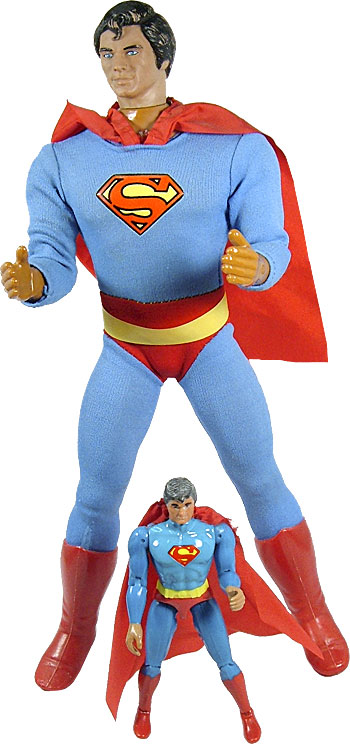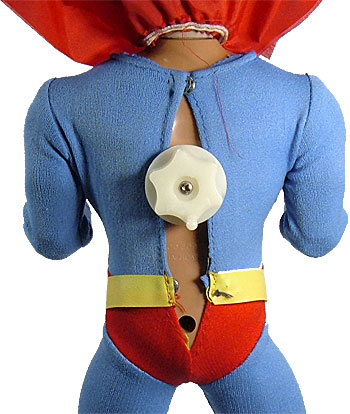"The [figure] I designed was a 12" hollow die-cast figure," John recalled. "The front and back of the torso were planned to be manufactured separately, then screwed together. It would have been 12 inches tall in order for it to work properly. The arms were operated by a screw thread, which rotated gears inside the shoulders to make the arms come together or move apart," thereby creating the figure's Crushing action. "The consumer could rotate the arms pointing forward, upward, or backward," he concluded.
 |
| Above: The 12" Denys Fisher "Power" Superman released in the U.K. and the smaller, American Die Cast Superman. |
While the concept was still in the drawing stages, John proposed similar mechanics around the waist, allowing the figure to bend forward and stand upright by way of a second gear. The planned toy would have had limited articulation. "Only the shoulders and the hips moved. The shoulders moved the arms in and out, and the hips moved the legs forward and down. This was enough to perform several interesting and difficult stunts,” John recalled.
"I think we decided that just the arm motion provided enough significant tricks, including lifting a chair, so that we rejected any further development of the bending waist feature. The waist-bending knob was eliminated prior to the building of the prototype," he stated.
Marty Abrams and Neal Kublan were impressed by the toy's ability to heft a chair, extending development into the "styling" phase (defined by John as "massaging and manipulating only the appearance of a product through sketches or drawings."). “The styling was original, and I believe the smaller die cast figure styling [Ed. Note: the Die Cast Superman that Mego issued in 1979, pictured at right] was derived from our prototype, in terms of musculature and proportion," noting that the chest cavity would have been much larger, to accommodate the internal mechanism. It was anticipated that the head would be decorated vinyl, and that the die-cast body would be covered with a cloth costume, similar to the 12" Superman.
According to John's recollection, "The prototype was made of machined billet aluminum." The intended die-cast material was called "Zamac," which is a composite of zinc, lead and tin. "It's very castable," he explained. The prototype was produced by Jim Williams at HMS, a group of model makers in Langhorn, PA that did extensive prototyping for Mego.
The metal was "another of the problems that contributed to the unacceptability of the item," John recalled, due to "the tremendous weight of all that Zamac. Suggestions of producing the lower half of the body in plastic relieved the concerns on that issue, but still to no avail."
Asked why production was scrapped, John clarified, "Production was not halted; development was halted. One of the first rules of designing toys is, "Don't hurt the kid!" It's not only bad for the kid; it's costly for the company. When we discovered that kids might apply the toy to their younger sibling's fingers, we reluctantly deep-sixed the project."
John recalled that the concept would not have extended to other characters in the WGSH line. "Hypothetically, [it was] for Superman only."
 |
| Above: Detail of the 12" Denys Fisher activating knob. |
Thanks to great Brian Heiler's vast knowledge of Foreign Mego products (not to mention the helpful photos that supplement this article), I asked John if the toy was similar to the 12" Denys Fisher "Power" Superman, which was issued exclusively in the United Kingdom. John exclaimed that he had never seen the Denys Fisher figure before, but that it was clearly derived from his original concept. "The knob I designed had more bumps, and it was made of metal," he began. "But that's the exact placement."
John's wife Linda, who worked for Mego from 1974-1978, overhead
our conversation and quipped, "Yeah, we sent a lot of the rejects
overseas!" John laughed and added, "It was common for
Mego to send "Rejected for U.S." projects overseas, to
see if some profit could be mustered from what would, otherwise,
be a dead-ended expense."
Further considering this revelation, John added, "[The fact] that the prototype wound up in the hands of the Brits, and that they made a plastic version (which, of course, defeats the whole idea of the figure being able to perform feats beyond a child's natural limitations), came as news to Linda and myself."
Mego's R& D staff worked at such a fast clip, it's not surprising John was unaware that his design was "re-purposed" for the English market. "I can just imagine Neal [Kublan] on the phone, with [a UK representative who is] demanding something unique, and Neal saying...
"I've got the
perfect thing for you!"
|